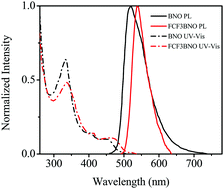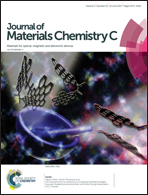High efficiency yellow organic light-emitting diodes with a solution-process feasible iridium based emitter
Abstract
Yellow emission plays an important role in many display and lighting applications, such as RGBY display or blue hazard free lighting sources, while a wet-process enables soft devices to be manufactured cost-effectively. We demonstrate here that high efficiency yellow organic light-emitting diodes can be made with an innovative solution-process viable iridium based material, bis[5-methyl-7-fluoro-8-trifluoromethyl-5H-benzo(c)(1,5)naphthyridin-6-one]iridium(picolinate) (FCF3BNO). The device exhibits a power efficacy of 49.2 lm W−1 at 1000 cd m−2 with an external quantum efficiency of 22.7% with a spin-coated emissive layer. A National Television Standards Committee (NTSC) color saturation of 110% is achievable by employing the yellow emission along with the standard RGB. The high efficiency may be attributed to the electron-withdrawing F and CF3 substitutions in the emitter to prevent self-quenching from dense packing. We also found that high efficiency can be achieved for wet-processed devices simply by balancing the injected holes and electrons with the help of energy-level matching hosts. The resultant RGBY composed of pure white light is 8% more friendly than the typical RGB counterpart from a retina protection perspective and also 8% better with respect to melatonin secretion.


 Please wait while we load your content...
Please wait while we load your content...